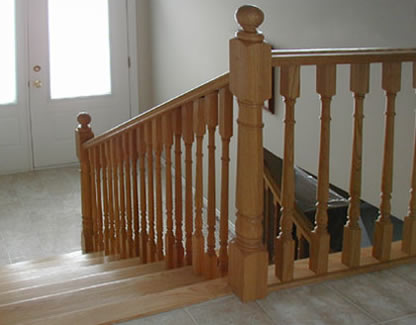Colonial Turned Wood Spindles:
These spindles have been the mainstay of the wood interior handrail business for a very long time. Today they are rarely installed, although I am sure, like bellbottom pants, they will return :). The decorating trend has moved toward both wood and metal spindles that are quite plain, often just square.
Having said that, some need these spindles to extend or repair an existing handrail. They are available, but only on special order. Use the contact page to enquire with details on size, wood species and quantities. The information below will give the details on what is commonly available.
These spindles are square on both the top and bottom, commonly referred to a “square-topped wood spindle”. This is to differentiate them from their close cousin, a “dowel topped spindle” that has been sharpened on the top like a pencil.
They are typically installed with a handrail (ie. our #4000) that has a groove in the underside to accept the size of the square top, in this case 1 5/16″.
Note: An identical spindle is made that is 1 3/4″ square (requires a custom handrail)

1 5/16″ x 1 5/16″ x 38″ Spindles

Application:
A 38″ spindle is typically used in all applications where the spindle is mounted on the end of the step.
Because of the angle of the handrail as it runs from the upper floor to the lower, you require two spindles, a shorter one at the front and a longer one at the back. The 38″ one is used on the front.
Most often the “Newel Post” or large main spindle that starts the handrail, is mounted half way into the first step. This eliminates the 38″ spindle on the first step.
Thus to calculate the number of 38″ spindles that you might require is pretty simple. Just count the number of stairs that you are installing and subtract one spindle for the first step if the newel post is as we suggest. That will give you the correct number of spindles required in your situation.
These spindles are also cut down to approximately 35.5″ for all horizontal runs.
Wood Species Available: Oak, Maple, Poplar (for painting)
1 5/16″ x 1 5/16″ x 42 ” Spindles

Application:
A 42 ” spindle is used in partnership with the 38″ wood spindle above, in all applications where the baluster is mounted on the end of the stair tread (as in the picture at the top of this page).
Because of the angle of the handrail as it runs from the upper to the lower level, you require two spindles, a shorter one at the front (the 38″) and a longer one at the back. The 42 ” spindle is used on the back of the step.
To calculate the number of 42 ” spindles that you might require is pretty simple. You will need one 42″ long spindle for every step.
42″ long spindles are also used in commercial applications where horizontal runs of handrail are required quite often to be 42″ in overall height.
NOTE: that often I get clients that are being told that an interior railing when the drop is over a certain height is also required to be 42″ high. I have yet to have this confirmed by building controls. Most often clients find that someone is trying to apply EXTERIOR railing requirements to an interior application. Ask for confirmation!
Wood Species Available: Oak, Maple, Poplar (for painting)
Horizontal Railing Installation:
To comply with MOST local building codes you must not have a space bigger than 4″ between adjoining spindles (and that is measured at the widest gap between the turnings).
If you would like to calculate the number of spindles you require for a horizontal interior wood handrail try this….take the number of inches of handrail that you need and divide that number by 5 you will end up with a pretty close estimate of the number of spindles you require for each horizontal run.
inches of handrail / 5 = approx. number of spindles needed
( I usually subtract one for every newel, but this really depends on where you measured your handrail lengths from)
